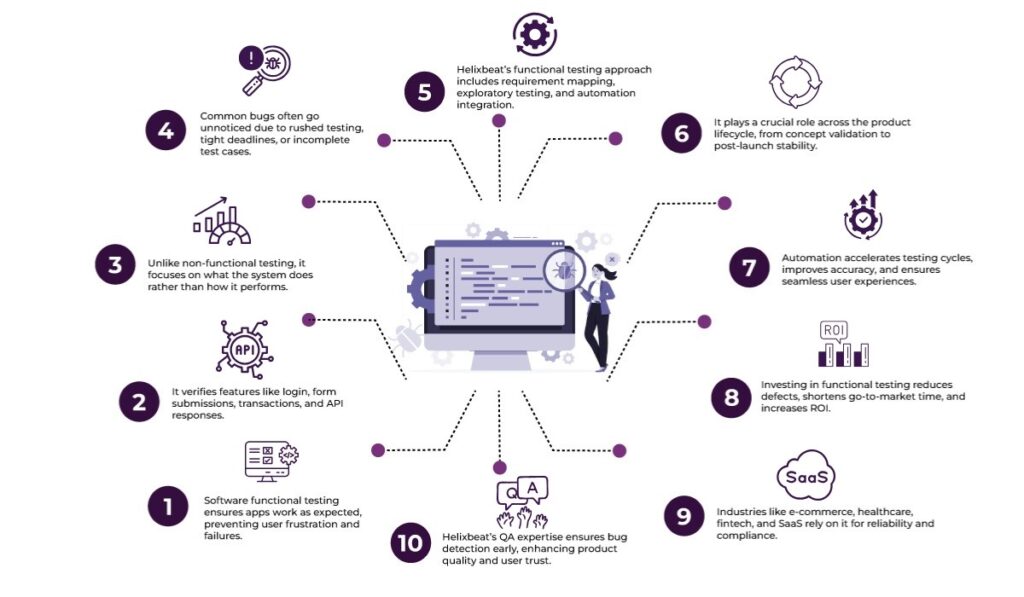Let’s say you’re using a new mobile banking app. You tap “Transfer Money,” enter the details, and hit confirm. But the screen freezes. You try again. Same result. That frustration you feel? That’s exactly what software functional testing aims to prevent.
Software functional testing ensures your app behaves exactly the way it’s supposed to, from login and form submissions to calculations and API responses. This is not just about meeting expectations; it’s about creating seamless digital experiences that retain users and build trust.
In an era where businesses operate in real time, any feature that fails to perform puts not just your brand reputation but also your revenue at risk. And that’s where companies like Helixbeat step in.
Table of Contents
What Is Software Functional Testing Really About?
Software functional testing evaluates a product’s features and operations against defined requirements. It’s not just testing for the sake of it; it’s about confirming that the software performs exactly as it was designed to.
Unlike non functional testing in software testing, which assesses performance, scalability, and security, functional software testing focuses entirely on whether each feature works as expected under normal usage conditions.
Some common examples include:
- Does the login button successfully authenticate the user?
- Can users search for, select, and purchase items without errors?
- Is user input correctly validated with appropriate messages?
Why Common Bugs Often Go Unnoticed?
Some bugs aren’t buried deep in the code—they’re right in front of us. Yet they only get flagged when users report them or when a major failure occurs after release.
This usually happens because:
- Development teams are under pressure to meet tight deadlines
- Regression testing is rushed or skipped altogether
- Test cases don’t cover all real-world user flows
That’s why consistent, well-planned software functional testing is critical—not just for quality but for customer trust and long-term product success.
What Makes Functional Testing Different from Non-Functional Testing?
Here’s a quick comparison to clarify:
| Aspect | Functional Testing | Non-Functional Testing |
| Focus | What the system does | How the system behaves |
| Metrics | Accuracy, compliance with requirements | Speed, scalability, usability |
| Examples | Input validation, login workflows | Load testing, Stress testing |
Both are crucial, but functional testing is usually the first checkpoint.
Helixbeat’s Approach to Functional Software Testing
Helixbeat offers comprehensive software functional testing services tailored to the stage and scale of your product. Our team ensures that every component of your application performs exactly as intended under real-world conditions, contributing to a stable and user-friendly experience.
Requirement Mapping & Test Planning
We begin with an in-depth analysis of your business goals and user expectations. These insights are translated into a targeted test strategy that prioritizes critical functionalities. It’s not just about writing test cases—it’s about aligning every test with real-world outcomes and long-term product success.
Feature Verification & Flow Coverage
Each core function is evaluated through:
- Positive and negative test scenarios
- Field validations
- Data flow mapping
- Error message behavior
Helixbeat simulates real user journeys and accounts for edge cases that are often overlooked, ensuring complete flow coverage and reliability.
Exploratory Testing
While scripted testing plays a vital role, our QA experts also conduct exploratory testing to uncover bugs that lie outside predefined scenarios. This proactive method speeds up bug detection and improves the overall user experience by identifying usability issues early in the cycle.
Integration with Automation Tools
To boost efficiency, Helixbeat leverages powerful automation tools like Selenium and Appium. Our hybrid testing model blends the accuracy of manual testing with the speed of automation, allowing for wider and faster test coverage across platforms.
How Functional Testing Contributes to Product Lifecycle Management?
Software functional testing is not just a quality assurance phase—it plays a critical role throughout the entire Product Lifecycle Management (PLM) process. By validating features at every stage, it supports better planning, smoother execution, and long-term product success.
- In Concept Development: Functional testing helps determine the feasibility of core features, ensuring ideas are grounded in technical reality.
- In Prototyping: It validates user journeys and key flows early, reducing rework and helping product teams gain stakeholder confidence before scaling development.
- In Post-Launch: Through iterative testing, it maintains stability and reliability as new features are added or refined.
Helixbeat’s functional software testing approach is embedded across the full product lifecycle, delivering continuity, quality, and performance from idea to maturity.
The Role of Automation in Functional Testing
While manual testing is essential for exploratory and user-centric scenarios, automation enhances productivity and consistency. In software functional testing, automation plays a key role in:
- Running repetitive test cases across multiple builds
- Accelerating regression testing cycles
- Testing large and complex feature sets efficiently
Helixbeat adopts automation strategically—not just to save time but to improve test coverage, reduce human error, and boost accuracy. Our balanced approach ensures every release meets high-quality standards without compromising speed.
The Hidden ROI of Functional Testing
Many decision-makers still view QA as a post-development task. However, investing early in robust functional software testing delivers long-term advantages:
- Up to 80% reduction in post-release defects
- Fewer rollbacks and emergency hotfixes
- Shorter go-to-market timelines
- Lower customer churn through improved user satisfaction
In fact, at Helixbeat, we’ve seen our clients achieve up to a 35% increase in ROI by leveraging our tailored QA solutions.
Functional Testing Use Cases That Matter
Functional software testing plays a vital role across industries where reliability, precision, and user trust are non-negotiable. Here’s how it adds value in real-world scenarios:
1. E-commerce Applications
From shopping cart behavior to payment gateway integration, every step must function without glitches. Software functional testing verifies that users can browse, add items, check out, and receive confirmations without encountering transaction failures or usability issues.
2. Healthcare Platforms
Systems that manage patient records, appointment bookings, and prescription generation demand exactness. Functional software testing ensures these life-critical operations work as intended, protecting both compliance and patient outcomes.
3. Fintech & Banking
Handling money requires flawless execution. Even a minor issue in transaction processing can erode trust. Helixbeat applies software functional testing to confirm accuracy in balance updates, fund transfers, and data encryption.
4. Enterprise SaaS Products
Large-scale platforms involve multiple user roles, complex dashboards, and varied permissions. Functional testing ensures that every workflow aligns with business logic and performs correctly under different access conditions.
These examples highlight how functional software testing isn’t just about finding bugs—it’s about safeguarding user experience and business continuity.
How We Detect Critical Bugs Early at Helixbeat?
Unlike teams that wait for user feedback, our QA experts work in parallel with developers and test continuously throughout the cycle. Here’s how we stay ahead:
Rigorous Test Suites- We build dynamic test libraries that evolve with your product, so nothing slips through the cracks.
Cross-Platform Coverage- Every new feature is tested across browsers, devices, and operating systems to avoid last-minute surprises.
Automation-Backed Regression- With each release, we re-evaluate previously tested functionalities through automation to catch regressions early.
End-User Simulation- We simulate real-world usage to identify bugs that standard test scripts may miss—bringing greater stability and usability.
Why do Founders and Tech Leaders Trust Us?
Whether you’re a startup with limited bandwidth or an enterprise scaling rapidly, we’ve got you covered with:
- Dedicated QA teams or flexible, on-demand support
- Transparent communication and real-time updates
- Scalable test strategies that grow with your roadmap
- Deep domain expertise across industries
At Helixbeat, we combine quality, agility, and business alignment to become more than just your testing vendor—we become your QA partner.
Final Words
Your users don’t care how much code you’ve written—they care whether the app works. That’s exactly what software functional testing guarantees.
Helixbeat transforms QA into a strategic advantage by helping you:
- Detect bugs before users find them
- Launch faster with fewer errors
- Deliver consistent user experiences
- Reduce costs and gain agility
Whether you need functional software testing for a new product or continuous testing throughout your product lifecycle, Helixbeat has the expertise, tools, and commitment to deliver.
Ready to eliminate critical bugs before they impact users? Partner with Helixbeat today for scalable, tailored QA services that put quality at the heart of your software.

FAQs
1. What is software functional testing?
It’s the process of verifying that software features work as expected based on defined requirements.
2. How is functional testing different from non-functional testing?
Functional testing focuses on what the software does; non-functional testing evaluates performance, load, and security.
3. Why is functional testing important?
It ensures your product works as intended, preventing bugs from affecting users’ post-launch.
4. What are the key types of functional testing?
Unit testing, integration testing, system testing, and user acceptance testing.
5. Can functional testing be automated?
Yes, especially repetitive scenarios and regression tests can be automated for speed and consistency.
6. How does Helixbeat approach functional testing?
Through requirement analysis, test planning, hybrid test models, and continuous QA support.
7. What industries benefit most from functional testing?
Fintech, e-commerce, healthcare, SaaS, and any industry relying on software-driven workflows.














